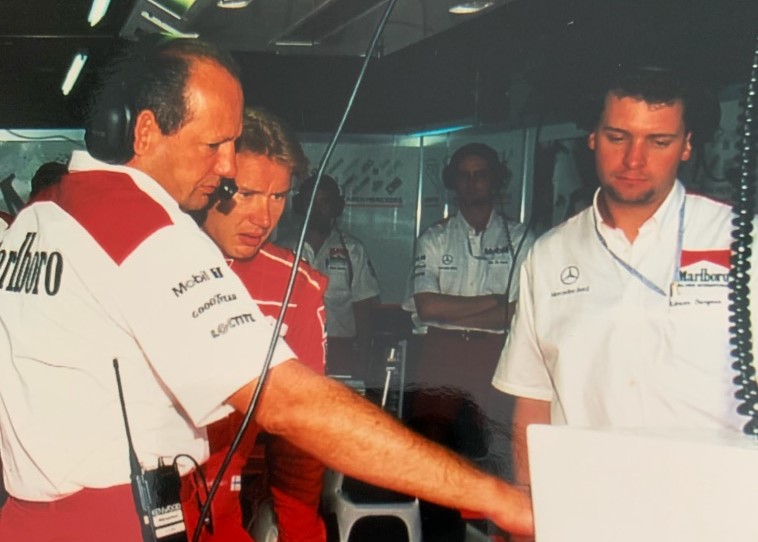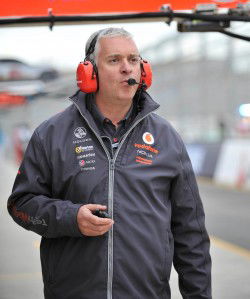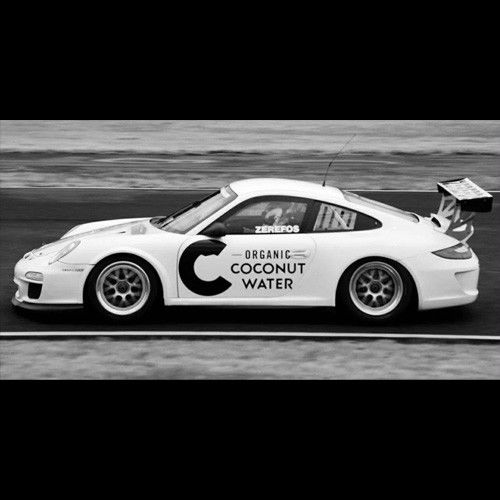

Downunder most will know Adrian Burgess for his success in Supercars, but before that, he was one of the top men in Formula 1 at McLaren.
Born in the United Kingdom, Burgess found an interest in motor racing from a young age, delivering copies of Autosport magazine and watching Formula 1 races in the early 1980s.
As his interest in the sport grew he began working in a local garage tinkering with cars at 13 years old.
He would work on Saturday and then volunteer at Donington Park come Sunday, getting his motor racing fix all with the ambition of scoring a job in motor racing.
While on his postal delivery run, Burgess spotted an advertisement in Autosport for a junior mechanic’s position at Richard Dutton Racing.
It wasn’t long before Burgess was out of home and on his way to begin working on single-seaters.
As he recalled, “I left home much to my mother’s disgust and shock, at 15-and-a-half and moved over to Grantham where this team was based.
“I wasn’t the academic that wanted to get onto university and things like that. At 15, I was very hands-on. I wanted to go to work and I wanted to go racing.
“I didn’t have the patience to put myself through university and go towards more of the engineering side of things. In those days it wasn’t as big as it is now.
“I just started off there at the bottom being a junior, sweeping the floor, and getting involved where I could.
“Before long, I was doing gear ratio changes, dampers and engines and all these things as well just running these two Formula Ford 2000s that we had.”

Soon enough Burgess had moved up the ranks to Formula 3 with Bowman Racing and by ‘89 had won a championship with David Brabham.
All the while he was racing on the support card at Grand Prix events, Burgess had his eye on a job in Formula 1.
“I always wanted to go to Formula 1,” he said.
“My first Formula 1 race as a spectator at 13 years old was the 1983 European Grand Prix at Brands Hatch.
“The following year a couple of mates and myself went down to Monaco for the F1. This is while we were still at school. So I’d got that F1 bug.
“A lot of the races in those early days, ‘85, ‘86, ‘87, a couple of times a year we were the supporting category for the F1.
“You were always looking over the fence wanting to go and be part of that and just work with them.
“Those cars were just amazing in those days. The drivers had big balls, they were really impressive to watch. I wanted to be part of that from a very early age.”
After his mother died at the end of ‘89, Burgess moved back home to live with his father and began working with another Formula 3 team, Paul Stewart Racing.
It was there that his relationship with Bruce Jenkins began, an engineer who had worked at McLaren in Formula 1 as a mechanic.
In that era, the big teams like McLaren were effectively running two operations; a two-car race team and a testing team that was capable of running four cars.
Burgess said opportunities were frequent in those days. McLaren had a mantra of taking impressionable mechanics out of Formula 3 and moulding them around the team.
“They liked picking the youngsters from Formula 3 because you didn’t arrive and already have these ideas of how you should do things,” he said.
“They wanted it done their way. They basically had a manual for everything and that’s how you do it. They didn’t want people varying how the cars are built.
“They were generally always looking for young mechanics, so it was fairly easy to get in there.
“My race engineer at the time, Bruce Jenkins, had been a mechanic on the race team at McLaren and he put a good word in for me.”
Soon enough he had an interview with the then McLaren team manager Dave Ryan.

“It was all fairly quick and straightforward, to be honest,” said Burgess.
“I still remember sitting there with Dave. When he was interviewing he said, ‘where do you want to see yourself in a few years’ time?’ And I turned around and said to him, ‘I want your job.’
“He just sort of laughed at me. But I wanted to progress through the system and go as far as I could.
“Me and Dave have been good friends ever since. So I moved back down to Surrey and stayed there for the next 10 years.
“It was daunting when you first walked in there,” he recalled of his first experience at McLaren.
“We’d won Formula 3 races and championships. We’d won Monaco, we’d won in Macau. We’d won some fairly big events in the junior formulae but then you turned up there and you’ve got Ayrton Senna and Gerhard Berger as your drivers.
“People like Allan McNish and Emmanuele Piero and all these guys are your test drivers. Yeah, it was fairly daunting as a 21-year-old.”
Burgess was thrust onto a plane to Japan and then Italy with the test team as the number two mechanic.
“When I ended up there in ’91 as a number two mechanic it was awesome. I turned up to work on a Monday and on Wednesday or Thursday I was off to Japan for a couple of weeks testing.
“Straight back from Japan we were straight to Imola for more testing and we were just absolutely flat out.
“In those days McLaren, our test team was bigger than our race team.
“We were capable. We had the staff and equipment and trucks and drivers and everything to run four cars on the same day in two different locations around the world.
“And we’d often do that. We’d often have a team of people in Japan doing all the Honda engine testing and had the ride system testing and stuff.
“We’d have two cars in Japan. At the same time, the same day we’d have two cars running in Europe.
“So testing was huge and you learnt a massive amount there. There are some very clever people there. A lot of people who are still there. They were really good mentors and people that you looked up to.
“You quickly learn the way they want things done and you can quickly work through the system there.”

One man influential in his development was Ron Dennis, who Burgess described as an ‘incredible taskmaster’.
“I learnt a lot of things at McLaren that I still rely on today and just standards that you set yourself in terms of presentation and punctuality and procedures.
“The level of preparation was just unprecedented at the time and they were acknowledged as being the most professional team and the best presented and all those things.
“Ron didn’t take any shit. If something didn’t look right he told you and you did it right and that was born into you early on.
“The guy’s impressive. He’s done so much for the sport and it was a privilege to do my trade there and learn the system.”
Burgess eventually progressed through the ranks from the test team as a number two mechanic to the race team as the number one mechanic.
That eventually saw him be part of the 1998 and ‘99 championship-winning efforts with Mika Häkkinen.
Ultimately though, Burgess hit the glass ceiling and left McLaren.
Dave Ryan believed that it wouldn’t be long before Burgess would be a chief mechanic but he didn’t have the patience to wait.
As it turned out, an opening wouldn’t come up for nearly a decade later.
Having begun his career as a mechanic, Burgess learned the inner workings of the team and subsequently transitioned into engineering and management roles elsewhere.
Burgess went back to Formula 3, building the highly successful Carlin operation in the early 2000s that led to the discovery of James Courtney.
He then went back to Formula 1 with the short-lived Midland F1 Team but eventually he came to Australia in 2007 where he’s stayed ever since.
As has been well documented, Burgess took Dick Johnson Racing to the Supercars title with Courtney in 2010 and went on to win several more titles with Jamie Whincup at Triple Eight Race Engineering after that.
Having had championship wins in Formula 1, Formula 3, and Supercars, Burgess said there are several common traits that each team has that culminates in success.
“Diligence, concentration, commitment, an eye for detail, and just the want to do it and to do it right,” he said.
“It’s like everything in life, there’s an easy way and there’s maybe a slightly harder way but it’s the right way.
“And if you don’t have that desire to push yourself and push those around you to do it the right way then taking the shortcut invariably doesn’t get you to where you need to be.
“You’re not winning – without blowing smoke up a few people’s arses – in Australia you can see a similar attitude between Ron Dennis and the way that Triple Eight has been run and Penske’s now being run. You can see the leadership.

“Leadership is a very strong thing as well. You can see how these teams are successful and you can see how other teams aren’t so successful.
“It comes down to the personnel and the philosophy and the ethos that you set inside that team and standards you set your workers and your people to operate at.
“It’s not surprising then that the successful teams are run by a very driven, single-minded individual who has got an eye for detail and a desire to do it the right way.
“But at the end of the day they’re all racers as well and it helps to be a racer.
“People, like Ron Dennis and Roland Dane, at the end of the day whether you like them or not, irrespective of how your dealings are with these people they are racers and they’ve got a passion for it and a desire to do it the right way.
“It’s the same with Roger Penske, he’s in that mould as well. These guys are racers and they do it the right way and they do it hard. They’re successful.”






















Discussion about this post